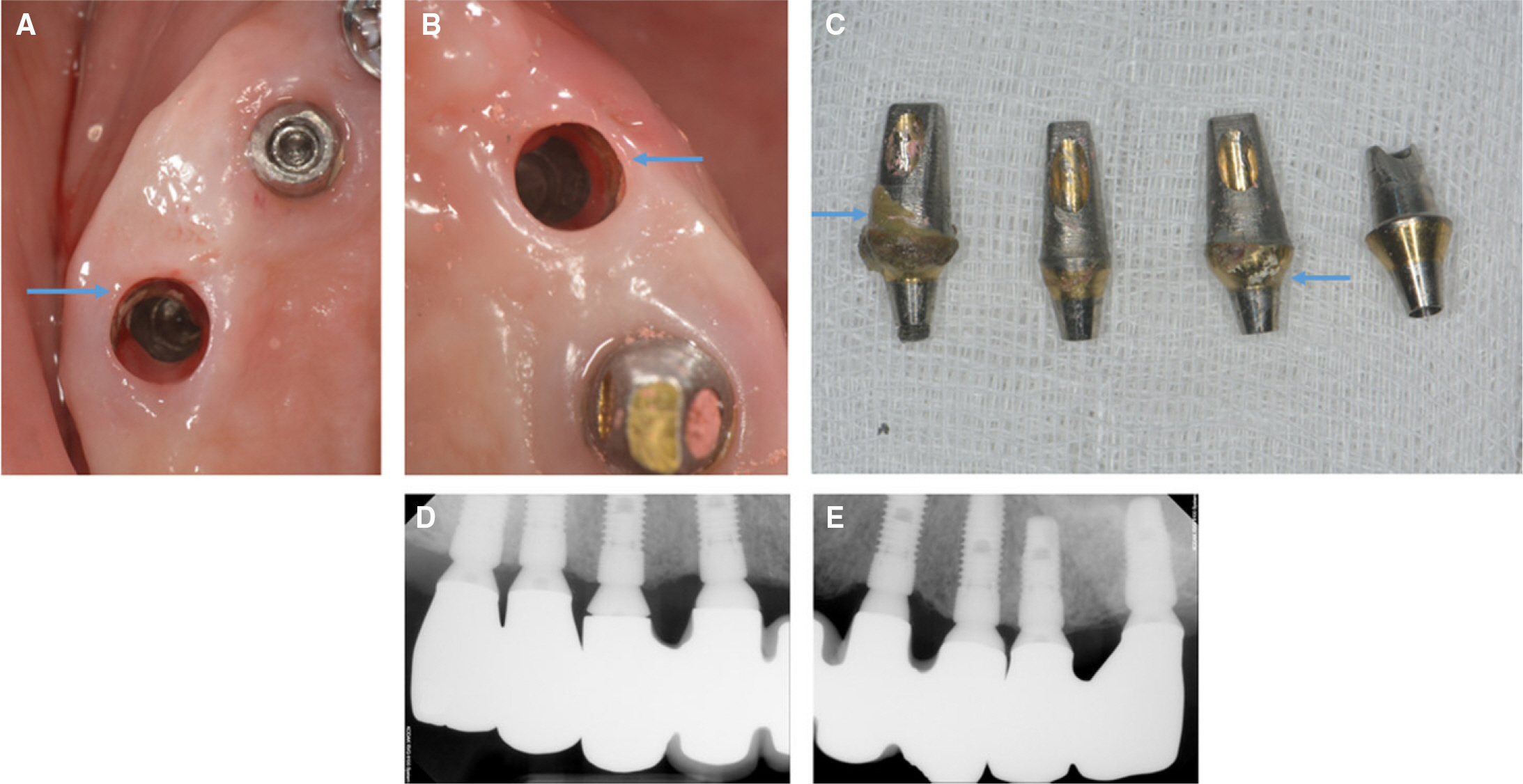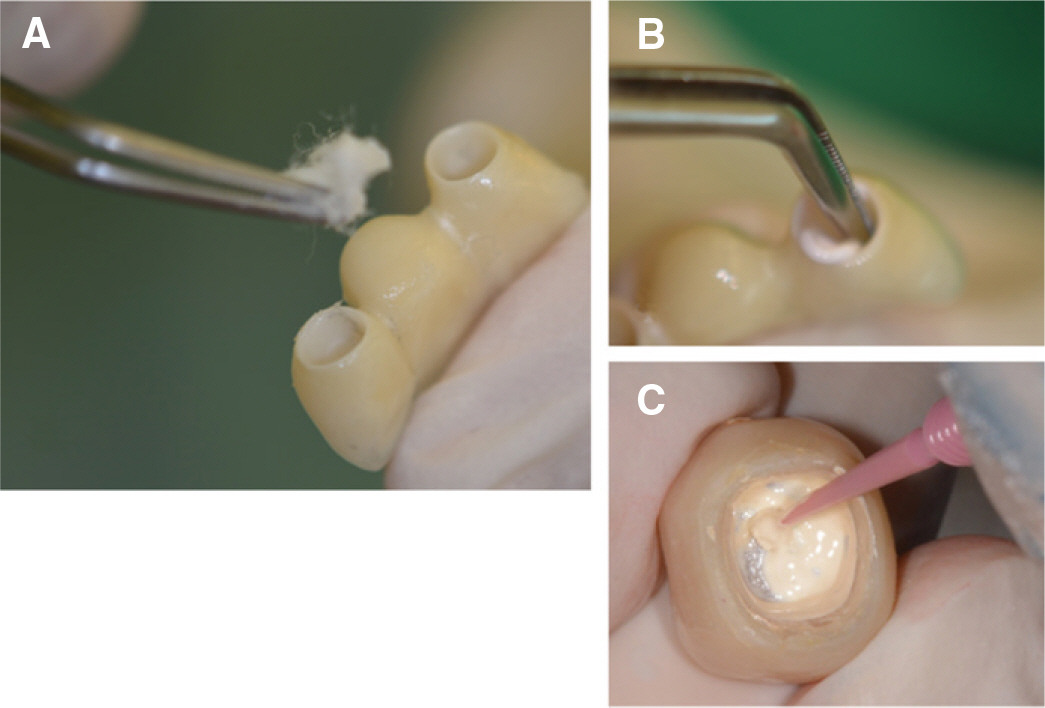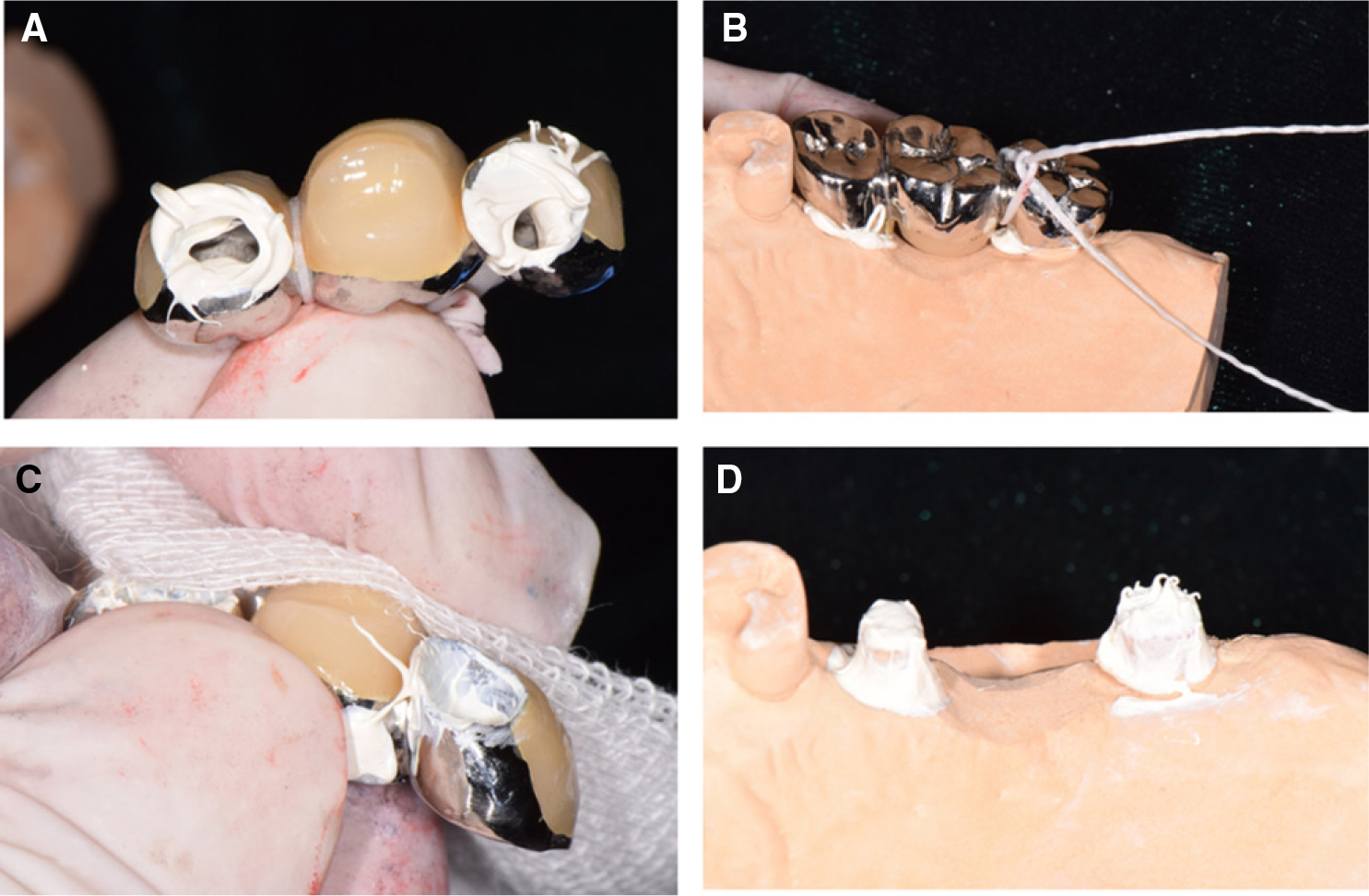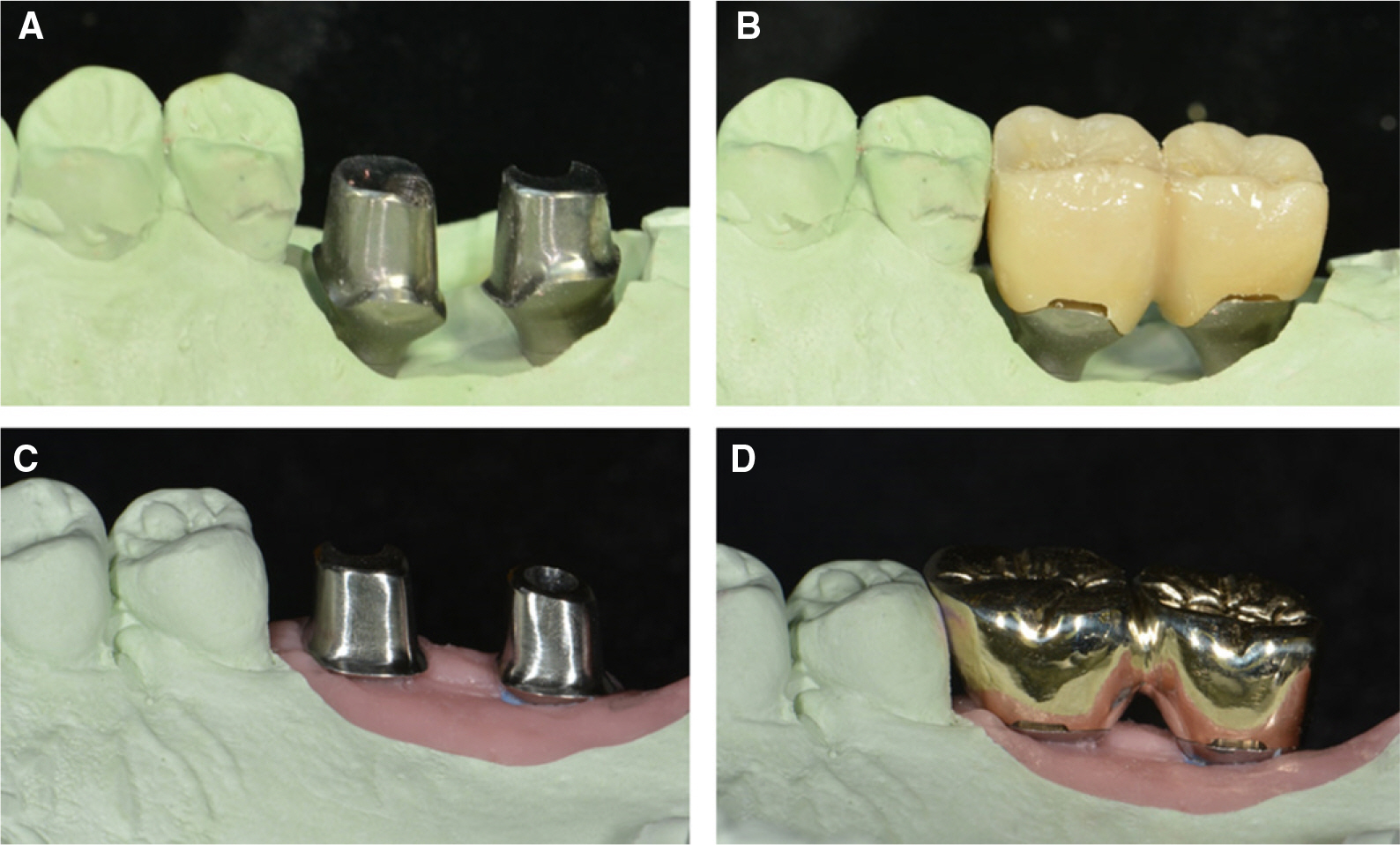J Korean Acad Prosthodont.
2016 Oct;54(4):458-467. 10.4047/jkap.2016.54.4.458.
A literature review on cementation of implant prosthesis
- Affiliations
-
- 1Department of Prosthodontics and Research Institute of Oral Science, College of Dentistry, Gangneung-Wonju National University, Gangneung, Republic of Korea. lila@gwnu.ac.kr
- KMID: 2388227
- DOI: http://doi.org/10.4047/jkap.2016.54.4.458
Abstract
- Cement-retained implant prosthesis has several advantages in the esthetic and occlusal aspects. However, the difficulty of the retrievability and the possibility of peri-implantitis induced by the cement excess would be a threatening factor to the implant prognosis. Peri-implantitis resulting from the remaining cement could occur later on to the patients with periodontitis history. Retention can be controlled by selecting the right cement type. Retention of the cement was the strongest in the resin cement, followed by resin modified glass ionomer cement, poIycarboxylate cement, zinc phosphate cement and glass ionomer cement. Retention of the provisional cement weakened after thermocycling. Other factors such as the abutment number, abutment alignment, height and taper of the abutment can also affect the total retention. To the success of the cement-retained prosthesis, it's important to select the right cement for the clinical purpose. The prosthesis should be fabricated in accordance with the biomechanical requirements. The prosthesis should be cemented with the techniques to reduce the excess cement as much as possible. In addition, the excess cement should be identified using the radiography and carefully removed.
Keyword
MeSH Terms
Figure
Reference
-
1.Katona TR., Goodacre CJ., Brown DT., Roberts WE. Forcemoment systems on single maxillary anterior implants: effects of incisal guidance, fixture orientation, and loss of bone support. Int J Oral Maxillofac Implants. 1993. 8:512–22.2.Nissan J., Narobai D., Gross O., Ghelfan O., Chaushu G. Long-term outcome of cemented versus screw-retained implant-supported partial restorations. Int J Oral Maxillofac Implants. 2011. 26:1102–7.3.Quirynen M., van Steenberghe D. Bacterial colonization of the internal part of two-stage implants. An in vivo study. Clin Oral Implants Res. 1993. 4:158–61.
Article4.Agar JR., Cameron SM., Hughbanks JC., Parker MH. Cement removal from restorations luted to titanium abutments with simulated subgingival margins. J Prosthet Dent. 1997. 78:43–7.
Article5.Berglundh T., Gislason O., Lekholm U., Sennerby L., Lindhe J. Histopathological observations of human periimplantitis lesions. J Clin Periodontol. 2004. 31:341–7.
Article6.Linkevicius T., Puisys A., Vindasiute E., Linkeviciene L., Apse P. Does residual cement around implant-supported restorations cause peri-implant disease? A retrospective case analysis. Clin Oral Implants Res. 2013. 24:1179–84.7.Pauletto N., Lahiffe BJ., Walton JN. Complications associated with excess cement around crowns on osseointegrated implants: a clinical report. Int J Oral Maxillofac Implants. 1999. 14:865–8.8.Gapski R., Neugeboren N., Pomeranz AZ., Reissner MW. Endosseous implant failure influenced by crown cementation: a clinical case report. Int J Oral Maxillofac Implants. 2008. 23:943–6.9.Korsch M., Obst U., Walther W. Cement-associated peri-im-plantitis: a retrospective clinical observational study of fixed implant-supported restorations using a methacrylate cement. Clin Oral Implants Res. 2014. 25:797–802.
Article10.Wilson TG Jr. The positive relationship between excess cement and peri-implant disease: a prospective clinical endoscopic study. J Periodontol. 2009. 80:1388–92.11.Wadhwani C., Hess T., Faber T., Piñeyro A., Chen CS. A descriptive study of the radiographic density of implant restorative cements. J Prosthet Dent. 2010. 103:295–302.
Article12.Han KH., Cheon HY., Kim MS., Shin SW., Lee JY. Comparative study on the radiopacity of different resin-based implant cements. J Korean Acad Prosthodont. 2014. 52:97–104.
Article13.Schneider RL. Evaluation of the retention of castings to endosseous dental implants. J Prosthet Dent. 1987. 58:73–8.
Article14.Squier RS., Agar JR., Duncan JP., Taylor TD. Retentiveness of dental cements used with metallic implant components. Int J Oral Maxillofac Implants. 2001. 16:793–8.15.Mansour A., Ercoli C., Graser G., Tallents R., Moss M. Comparative evaluation of casting retention using the ITI solid abutment with six cements. Clin Oral Implants Res. 2002. 13:343–8.
Article16.Wadhwani C., Chung KH. Bond strength and interactions of machined titanium-based alloy with dental cements. J Prosthet Dent. 2015. 114:660–5.
Article17.Maeyama H., Sawase T., Jimbo R., Kamada K., Suketa N., Fukui J., Atsuta M. Retentive strength of metal copings on prefabricated abutments with five different cements. Clin Implant Dent Relat Res. 2005. 7:229–34.
Article18.Pan YH., Lin CK. The effect of luting agents on the retention of dental implant-supported crowns. Chang Gung Med J. 2005. 28:403–10.19.Michalakis KX., Pissiotis AL., Hirayama H. Cement failure loads of 4 provisional luting agents used for the cementation of implant-supported fixed partial dentures. Int J Oral Maxillofac Implants. 2000. 15:545–9.20.Ramp MH., Dixon DL., Ramp LC., Breeding LC., Barber LL. Tensile bond strengths of provisional luting agents used with an implant system. J Prosthet Dent. 1999. 81:510–4.
Article21.Cho JH., Jeong CM., Jeon YC. Effects of various cements and thermocycling on retentive strengths of cemented implant-supported prostheses. J Korean Acad Prosthodont. 2003. 41:466–75.22.Kim Y., Yamashita J., Shotwell JL., Chong KH., Wang HL. The comparison of provisional luting agents and abutment surface roughness on the retention of provisional implant-supported crowns. J Prosthet Dent. 2006. 95:450–5.
Article23.Sheets JL., Wilcox C., Wilwerding T. Cement selection for cement-retained crown technique with dental implants. J Prosthodont. 2008. 17:92–6.
Article24.Akça K., Iplikçioğlu H., Cehreli MC. Comparison of uniaxial resistance forces of cements used with implant-supported crowns. Int J Oral Maxillofac Implants. 2002. 17:536–42.25.Lee DH., Suh KW., Ryu JJ. Comparison of retentive forces of temporary cements and abutment height used with implant-supported prosthesis. J Korean Acad Prosthodont. 2008. 43:280–9.26.Bresciano M., Schierano G., Manzella C., Screti A., Bignardi C., Preti G. Retention of luting agents on implant abutments of different height and taper. Clin Oral Implants Res. 2005. 16:594–8.
Article27.Jung JW., Kim JH., Kim SJ., Moon HS., Shim JS. The comparison of the retention of the full veneer casted gold crowns with different implant abutment shapes and types of cements. J Dent Rehabil Appl Sci. 2009. 25:403–15.28.Wadhwani C., Hess T., Piñeyro A., Opler R., Chung KH. Cement application techniques in luting implant-supported crowns: a quantitative and qualitative survey. Int J Oral Maxillofac Implants. 2012. 27:859–64.29.Canullo L., Cocchetto R., Marinotti F., Oltra DP., Diago MP., Loi I. Clinical evaluation of an improved cementation technique for implant-supported restorations: a randomized controlled trial. Clin Oral Implants Res. 2015 Apr 6.
Article30.Galva′n G., Kois JC., Chaiyabutr Y., Kois D. Cemented implant restoration: A technique for minimizing adverse biologic consequences. J Prosthet Dent. 2015. 114:482–5.31.Wadhwani C., Piñeyro A. Technique for controlling the cement for an implant crown. J Prosthet Dent. 2009. 102:57–8.
Article32.Chee WW., Duncan J., Afshar M., Moshaverinia A. Evaluation of the amount of excess cement around the margins of cement-retained dental implant restorations: the effect of the cement application method. J Prosthet Dent. 2013. 109:216–21.
Article33.Schwedhelm ER., Lepe X., Aw TC. A crown venting technique for the cementation of implant-supported crowns. J Prosthet Dent. 2003. 89:89–90.
Article34.Begum Z., Sonika R., Pratik C. Effect of different cementation techniques on retained excess cement and uniaxial retention of the implant-supported prosthesis: an in vitro study. Int J Oral Maxillofac Implants. 2014. 29:1333–7.
Article35.Hess TA. A technique to eliminate subgingival cement adhesion to implant abutments by using polytetrafluoroethylene tape. J Prosthet Dent. 2014. 112:365–8.
Article36.Wadhwani C., Rapoport D., La Rosa S., Hess T., Kretschmar S. Radiographic detection and characteristic patterns of residual excess cement associated with cement-retained implant restorations: a clinical report. J Prosthet Dent. 2012. 107:151–7.
Article37.Preiskel HW., Tsolka P. Cement- and screw-retained implant-supported prostheses: up to 10 years of follow-up of a new design. Int J Oral Maxillofac Implants. 2004. 19:87–91.38.Vindasiute E., Puisys A., Maslova N., Linkeviciene L., Peciuliene V., Linkevicius T. Clinical Factors Influencing Removal of the Cement Excess in Implant-Supported Restorations. Clin Implant Dent Relat Res. 2015. 17:771–8.
Article39.Schweitzer DM., Berg RW., Mancia GO. A technique for retrieval of cement-retained implant-supported prostheses. J Prosthet Dent. 2011. 106:134–8.
Article40.Prestipino V., Ingber A., Kravitz J., Whitehead GM. A practical approach for retrieving cement-retained, implant-supported restorations. Quintessence Dent Technol. 2001. 24:182–7.
- Full Text Links
- Actions
-
Cited
- CITED
-
- Close
- Share
- Similar articles
-
- Occlusion for implant-supported fixed dental prostheses in partially edentulous patients: a literature review and current concepts
- Customized abutment and screw-type implant prostheses after cementation based on the digital intra-oral impression technique
- A modified technique for extraoral cementation of implant retained restorations for preventing excess cement around the margins
- Full Cementation in Revision Total Knee Arthroplasty Using a Constrained Condylar Knee Prosthesis with an Average 7-Year Follow-up
- Clinical cases of implant-supported fixed dental prosthesis using modified lingual screw system (T-screw system)







